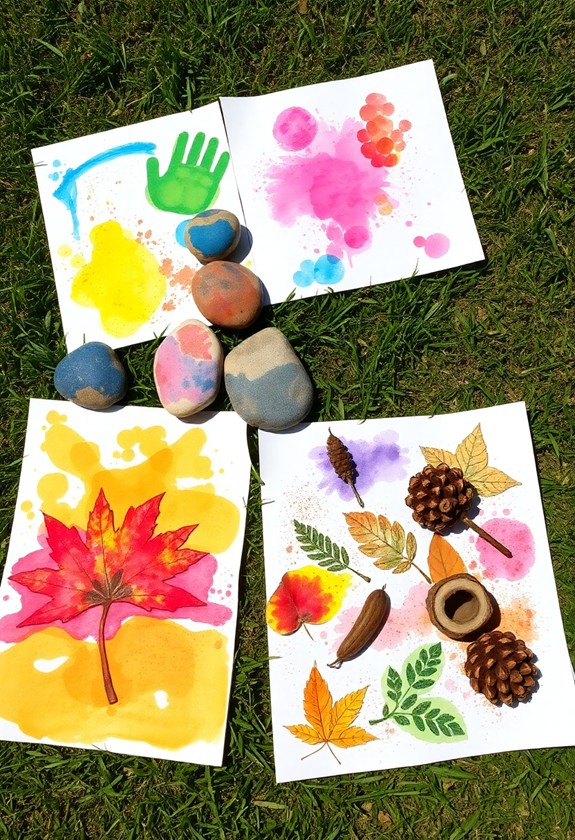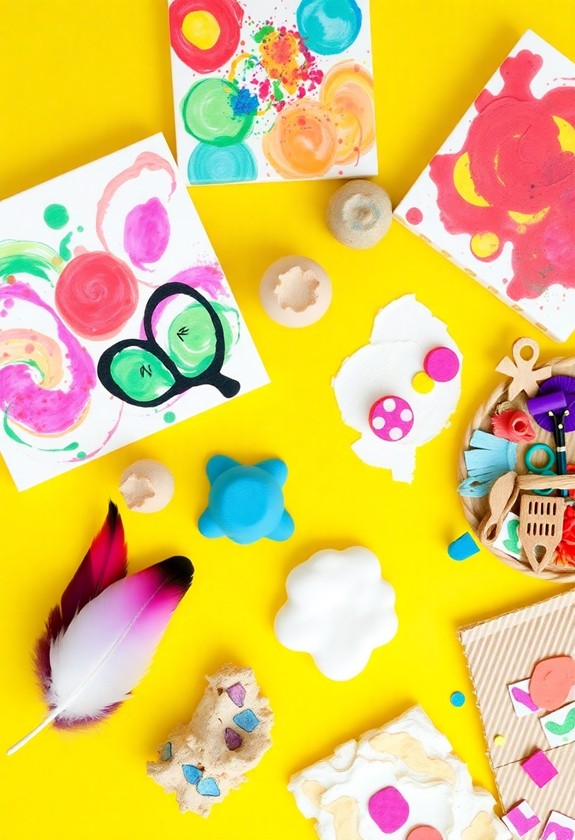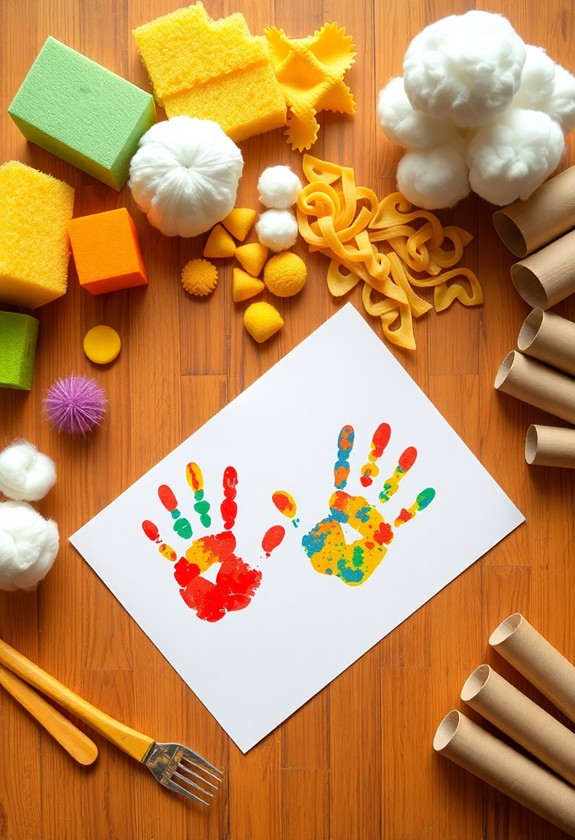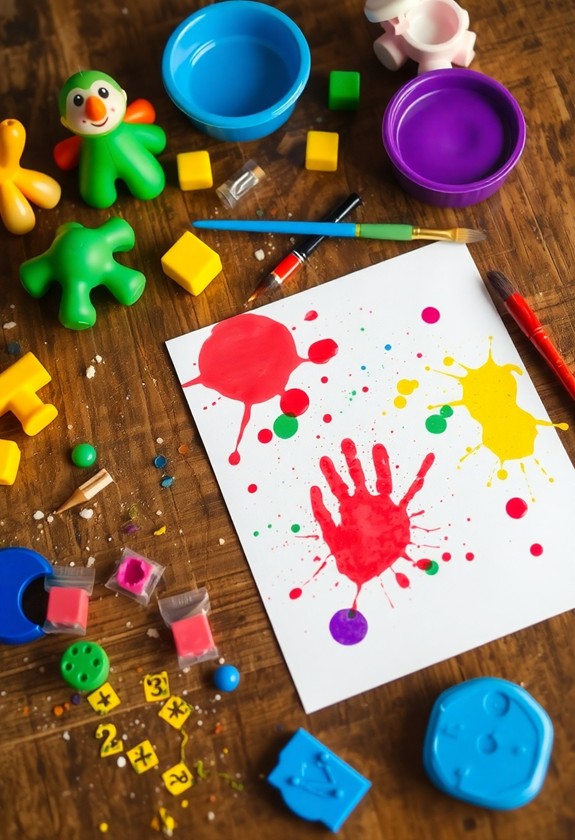Get ready to release your toddler's creativity outdoors with these fantastic sensory art activities! Try nature paint brushes using sticks and leaves, or let them squish and mold mud pie masterpieces. Sidewalk chalk drawing adds a fun twist to driveway art. For messy fun, set up outdoor finger painting stations or create natural material collages. Textured sand art brings the beach to your backyard, as bubble wrap stomping paintings combine art with giggles. Finally, engage their senses with scented watercolor experiments. These activities not only spark imagination but also develop fine motor skills and sensory awareness. Uncover how each activity can turn your backyard into an artistic playground!
Creative Highlights
- Nature-inspired activities like creating paint brushes from sticks and leaves encourage outdoor exploration and creativity.
- Mud pie masterpieces combine messy play with artistic expression, fostering tactile exploration and sustainability awareness.
- Outdoor finger painting with washable paints promotes cognitive development and sensory exploration in a natural setting.
- Bubble wrap stomping paintings merge art, movement, and sound for a multi-sensory creative experience.
- Scented watercolor experiments engage multiple senses, enhancing artistic awareness while exploring colors and aromas.
Nature Paint Brushes
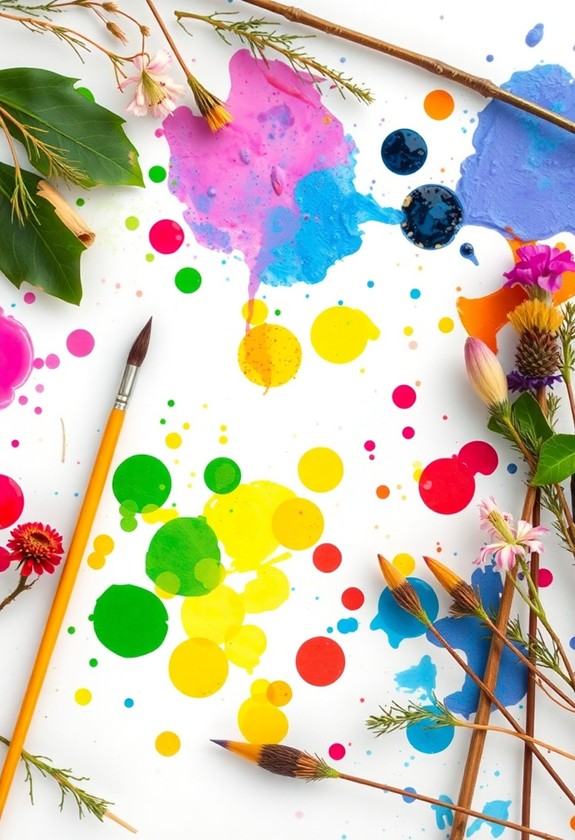
How can you transform nature into art tools? It's easy and fun! Grab your toddler and head outside for an exciting art adventure. You'll need:
- Sticks, leaves, flowers, grass
- Paint
- Paper or cardboard
Now, let's get creative! Here's what to do:
- Collect natural items
- Secure them to sticks with rubber bands
- Dip in paint and start brushing!
This activity not only promotes fine motor skills but likewise encourages outdoor exploration and nature appreciation. It's a perfect way to combine art with environmental awareness.
Watch as your little one creates masterpieces with their unique brushes. They'll love the different textures and patterns each item makes. Pine needles create spiky strokes, whereas leaves make broad swipes. It's a sensory explosion!
This activity isn't just artsy – it's a nature lesson too. Talk about the plants you find and their colors. You're nurturing budding artists and scientists at once!
Mud Pie Masterpieces
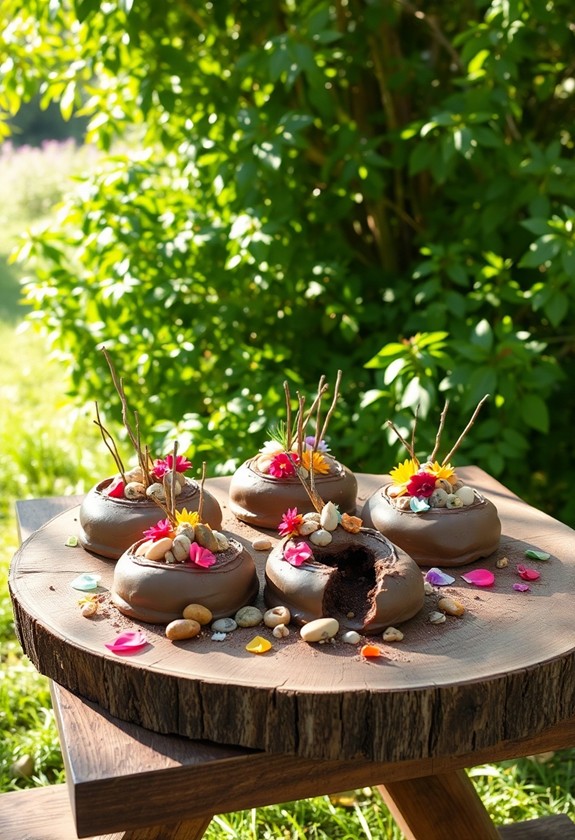
Kids love getting messy, and what's messier than mud? Turn your backyard into an art studio with mud pie masterpieces! This activity is perfect for little hands and big imaginations. Nature-based crafts like mud pies encourage creativity and outdoor exploration as they connect children with their environment. These eco-friendly projects additionally promote sustainability and environmental responsibility.
Here's how to create mud-tastic art:
- Find a patch of dirt and add water to make gooey mud.
- Give your toddler pie tins, muffin tins, or plastic containers.
- Let them scoop, pour, and mold the mud into "pies."
- Encourage decoration with twigs, pebbles, and flowers.
Watch as your little Picasso creates earthy works of art! They'll love squishing the cool mud between their fingers and designing their muddy masterpieces. It's a sensory explosion that'll have them giggling with joy. Plus, it's a great way to teach about textures and nature. Just be prepared for some muddy clean-up – but it's worth it for the muddy memories!
Sidewalk Chalk Sensory Drawing
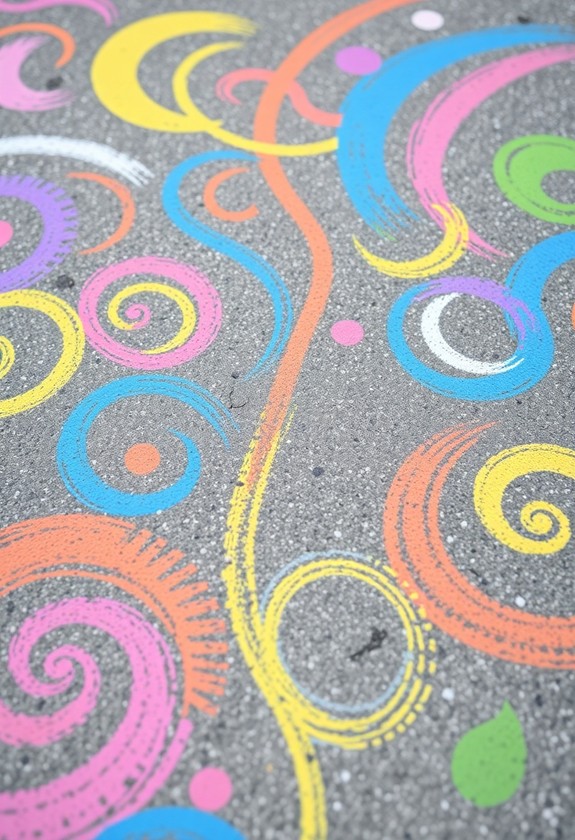
Moving from mud to chalk, we're taking our art to the sidewalk! Get ready for some colorful, tactile fun with sidewalk chalk sensory drawing. Here's how to make it extra exciting:
- Crush chalk into powder and mix with water for a paint-like consistency.
- Add textures like sand or glitter for a sensory boost!
- Use sponges, brushes, or even your hands to create unique patterns.
Let your little one's imagination run wild! They can draw:
- Massive rainbows
- Squiggly monsters
- Their own "hopscotch" board
Don't forget to engage their senses. Ask them:
- How does the chalk feel?
- What colors are they using?
- Can they make big and small shapes?
Outdoor Finger Painting
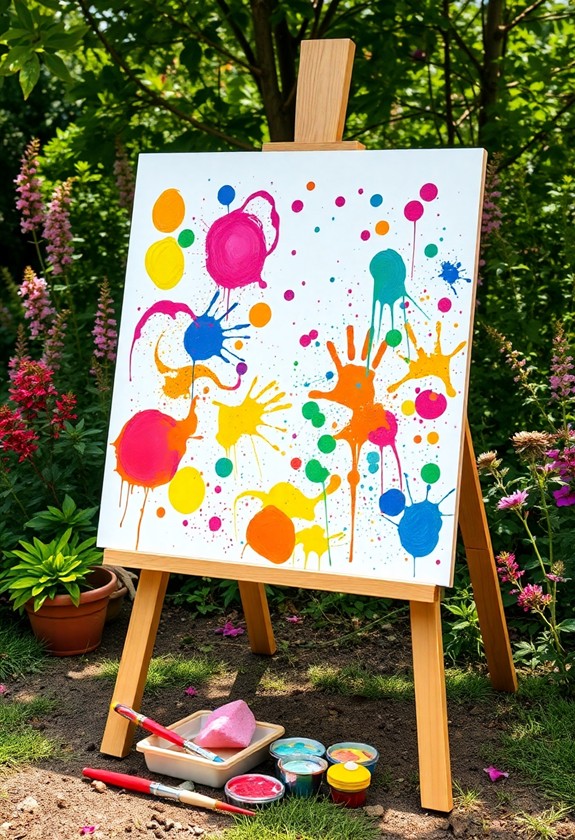
Finger painting takes on a whole new dimension when you move it outdoors. It's a messy, sensory adventure that'll have your toddler squealing with delight! Here's how to make it happen:
- Set up a painting station outside
- Use washable, non-toxic paints
- Provide large sheets of paper or a smooth surface
Let your little one go wild! They can use their hands, feet, or even toy cars to create masterpieces. The best part? Clean-up is a breeze with a garden hose! This activity promotes cognitive development and augments fine motor skills through the manipulation of paint and various tools.
But wait, there's more! Try these fun twists:
- Add natural elements like leaves or flowers
- Use pudding for an edible option
- Create a group mural on a large tarp
Outdoor finger painting isn't just art – it's a full-body sensory experience that'll have your toddler begging for more. Get ready for some colorful fun in the sun!
Natural Material Collages

Along with outdoor finger painting, natural material collages offer a delightful way for toddlers to explore textures and colors found in nature. It's time to get sticky and creative! Here's how to make these awesome artworks:
- Gather natural materials: leaves, flowers, twigs, pebbles
- Provide a sturdy base: cardboard or thick paper
- Offer child-safe glue or double-sided tape
To improve your toddler's art exploration, consider setting up a dedicated art space where they can freely create and experiment with different materials. This encourages their creativity and independence.
Let your little one go wild! They'll love arranging and sticking their finds onto the base. Watch as they create unique masterpieces! This activity isn't just fun – it's educational too. Your toddler will learn about:
- Different textures (smooth, rough, soft)
- Various shapes and sizes
- Colors in nature
Plus, it's a great way to practice fine motor skills. So, head outside and let nature be your art supplier. It's time to stick it to boring activities!
Textured Sand Art
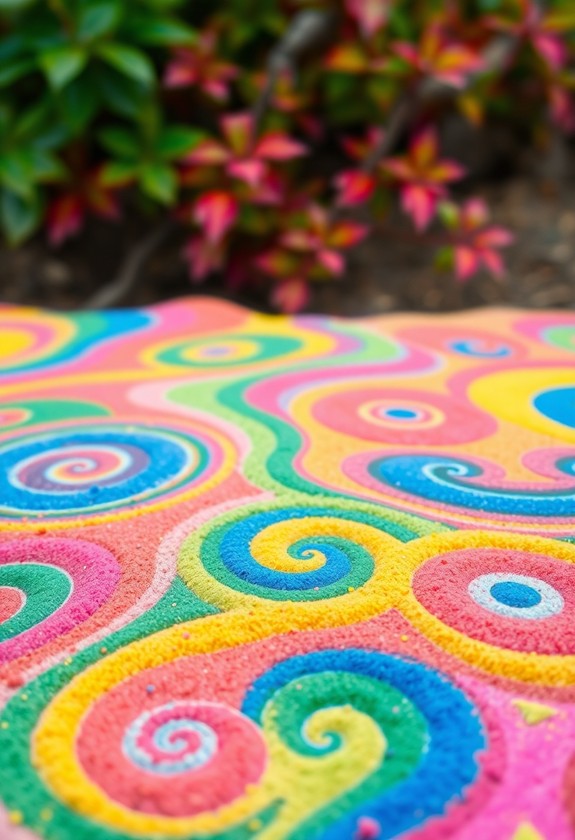
From natural collages, let's shift our focus to another exciting outdoor art activity: textured sand art. This fun, messy project will have your toddler squealing with delight! Here's how to get started:
- Gather supplies:
- Colored sand
- Glue
- Sturdy paper or cardboard
- Various textured items (leaves, pebbles, twigs)
- Large bubble wrap sheets
- Washable, non-toxic paint
- Paper or canvas
- Enthusiasm (and lots of it!)
Your child will love feeling the gritty sand and smooth objects as they create a unique masterpiece. It's a "sand-sational" way to investigate textures and colors outdoors!
Bubble Wrap Stomping Paintings
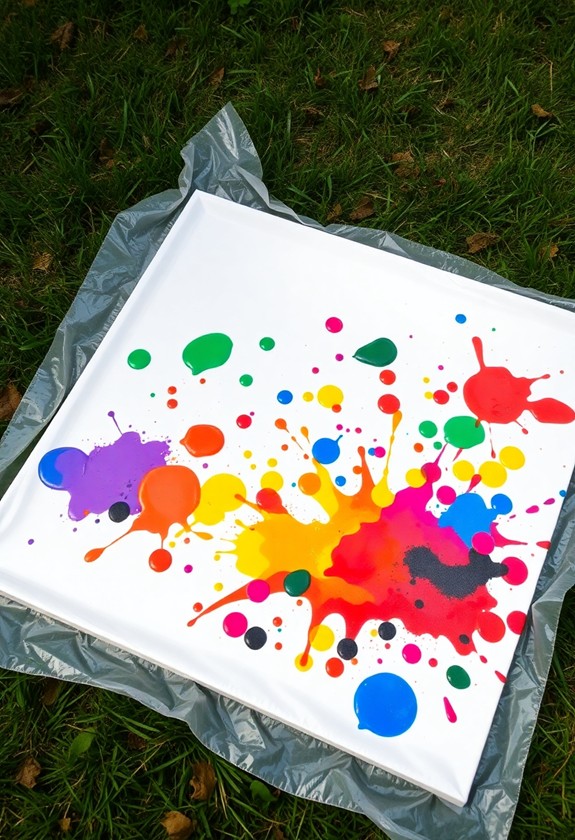
This next activity combines art, movement, and sensory play in one exhilarating package. Get ready for Bubble Wrap Stomping Paintings! It's a blast for your little ones and a feast for their senses. Using washable, non-toxic paint guarantees easy cleanup and promotes a safe, worry-free creative experience for toddlers.
Here's what you'll need:
How to "pop" this activity into action:
- Lay out the bubble wrap on a flat surface.
- Squirt different colors of paint onto the bubble wrap.
- Place paper or canvas on top.
- Let your toddler go wild! They can stomp, jig, or hop on the artwork.
The result? A unique masterpiece full of textures and surprises! Plus, your child will love the satisfying "pop" sounds as they create. It's a "wrap" – this activity is bound to be a hit!
Scented Water Color Experiments
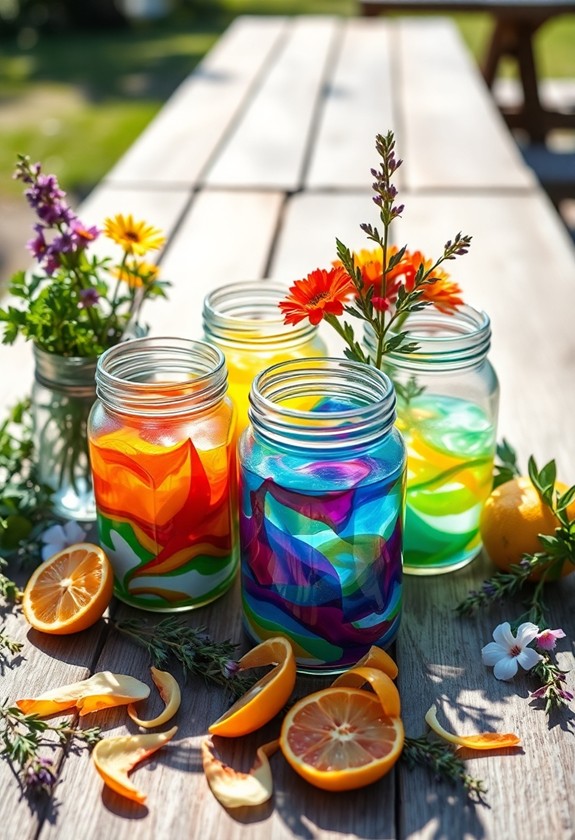
Let's awaken your toddler's sense of smell with our next artistic adventure! Scented water color experiments are a fantastic way to engage multiple senses at once. Here's how to get started:
- Gather supplies: water colors, paper, crucial oils, and brushes
- Add a drop of crucial oil to each water color well
- Let your little one sniff the scented paints – what do they smell?
- Encourage painting and color mixing
Watch as your toddler creates aromatic masterpieces! They'll love the burst of scents with each brushstroke. Try different oil combinations for a truly nose-worthy experience. Lavender for purple, lemon for yellow, and peppermint for green – oh my! This activity isn't just fun, it's scent-sational learning too. Your child will investigate color theory, develop fine motor skills, and expand their olfactory vocabulary. So grab those paints and get ready for a smell-ebration of creativity!
Curious Little Questions
How Can I Protect My Toddler's Skin During Outdoor Art Activities?
Protect your toddler's skin like it's made of gold! Here's how:
- Slather on sunscreen with SPF 30+
- Dress them in lightweight, long-sleeved clothes
- Pop on a wide-brimmed hat
- Set up activities in shady spots
- Limit sun exposure during peak hours (10 am – 4 pm)
Don't let the sun rain on your parade! With these tips, your little Picasso can create masterpieces outdoors without worry. Remember, skin safety is no joke – it's a brush with brilliance!
What's the Best Way to Document and Preserve Outdoor Art Creations?
Ready to preserve your little Picasso's outdoor masterpieces? You've got options! Snap photos of their creations in natural light – it's quick and easy. For 3D art, try casting it in plaster or resin. Love scrapbooking? Press flowers or leaves from their nature art into a book. And don't forget to date everything! Create a digital album or art journal to track their progress. It's a fun way to watch their creativity grow and bloom over time!
Are There Any Eco-Friendly Alternatives to Traditional Art Supplies?
You bet there are eco-friendly art supplies! Let's explore the colorful world of green creativity. Nature's palette is waiting for you! Try:
- Homemade paints using berries, spices, or vegetables
- Clay dug from your own backyard
- Rocks and leaves as canvases
- Twigs and grass for brushes
These earth-friendly options aren't just good for the planet, they're a blast to use! Plus, you'll save some green by going green. It's a win-win situation that'll have you creating masterpieces in no time!
How Can I Involve Children With Sensory Sensitivities in Outdoor Art Activities?
You've got this! For kids with sensory sensitivities, outdoor art can be a blast with a few tweaks. Try these fun ideas:
- Start small: Begin with short, gentle sessions
- Offer choices: Let them pick activities they're comfy with
- Use natural materials: Leaves, sticks, and rocks are less overwhelming
- Create a calm zone: Set up a quiet space for breaks
- Go hands-free: Try blowing bubbles or water painting with spray bottles
What Precautions Should I Take for Allergies During Nature-Based Art Projects?
You've got to be super-careful with allergies during nature art projects! Here's how:
- Check with parents about known allergies first
- Avoid common allergens like pollen-heavy flowers or nuts
- Have kids wear gloves when handling plants
- Keep antihistamines and first-aid kit handy
- Wash hands before and after activities
- Choose hypoallergenic materials when possible
- Be watchful for any allergic reactions

